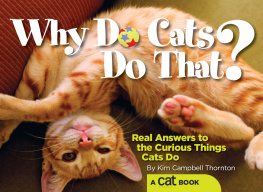Falling Felines and Fundamental Physics
FALLING FELINES AND FUNDAMENTAL PHYSICS
GREGORY J. GBUR
Yale UNIVERSITY PRESS
New Haven and Lodon
Copyright 2019 by Gregory J. Gbur
All rights reserved.
This book may not be reproduced, in whole or in part, including illustrations, in any form (beyond that copying permitted by Sections 107 and 108 of the U.S. Copyright Law and except by reviewers for the public press), without written permission from the publishers.
Yale University Press books may be purchased in quantity for educational, business, or promotional use. For information, please e-mail (U.K. office).
Set in Adobe Garamond type by Newgen North America, Austin, Texas.
Printed in the United States of America.
Library of Congress Control Number: 2019935202
ISBN: 978-0-300-23129-8 (hardcover : alk. paper)
A catalogue record for this book is available from the British Library.
This paper meets the requirements of ANSI/NISO Z39.48-1992
(Permanence of Paper).
10 9 8 7 6 5 4 3 2 1
Dedicated to my extended cat family:
Sasha, Zoe, Sophie, Cookie, Rascal, Mandarin, Dolly,
Mitzi, Daisy, Hobbes, and the late Simon, Sabrina,
Fluff, Goldie, and Milo
Contents
Preface: Cats Are Crazy
Its fair to say that cats are a bit crazy. As ambush predators that tend to hunt alone, cats have developed an intelligence that allows them to stalk their prey, track it even when it is out of sight, and anticipate its actions. With this intelligence comes a natural playfulness and curiosity that regularly gets cats into trouble. No wonder everyone knows the phrase curiosity killed the cat.
Fortunately, over countless eons of evolution, cats have also developed important skills that allow them to get out of difficult situations almost as easily as they get into them. Foremost among these is a technique that has been known by many names over the years: cat-turning, the cat-righting reflex, the cat flip, the cat twist. All these names refer to the cats rather remarkable ability to land on its feet when it falls from a height, no matter what position it was in when it started falling. Cats can do this twist even from small drops of two to three feet by turning in a fraction of a second.
It is a life-saving technique. Cats are often said to have nine lives; if we accept this proverb at face value, I would say that at least four of these lives are due to the cat-righting reflex. Having worked with feline rescue groups, I can attest to the skills of cats.On one occasion, I went to assist in the rescue of a foster cat that had escaped from a home and was high up in a tree. A cherry picker was called so the rescue group could approach the panicked cat and try to coax her from her perch, which was about one hundred feet high. The cat opted to jump, and hit the ground running; when she was brought to the vet, her only injury from the fall was a hairline fracture, which healed.
Cats seem to know that theyve got skills, and they like to flaunt them.One member of my extended kitty family, Sophie, used to walk on the outside of the railing at the top of the second-floor staircase and ignored all attempts to discourage her. One day my wife happened to see Sophie slipthere was a glimpse of a pair of cat paws, with claws dug into the woodand then Sophie fell. She landed unhurt but fortunately discouraged from making additional daredevil strolls.
Similar stories of spectacular tumbles abound, and the cats ability to right itself is common knowledge.What is not broadly recognized, however, is that a significant amount of science is involved in the cats ability.The physics and physiology of cat-turning have fascinated, frustrated, and baffled scientists for centuries. Although the problem has largely been solved, there are still arguments over the finer details of the cats ability, and it continues to inspire modern technology.
I first came across the falling cat problem in 2013 while writing my blog Skulls in the Stars, which covers topics from physics to the history of science to weird fiction. I tend to browse old scientific journals for interesting things to write about, and one day I stumbled across the iconic 1894 photographs of a falling cat produced by the French physiologist tienne-Jules Marey. Intrigued, I wrote a post about Marey and other early falling cat researchers titled Cat-Turning: The 19th-Century Scientific Cat-Dropping Craze!
But I wasnt sure that my original explanation for the cats ability was correct, so I looked for other published research on the falling cat problem. And I kept finding more.
Scientists have been intrigued by falling cats for almost as long as science itself has existed, and this interest has extended across multiple disciplines. Every time one discipline loses interest in the cat problem, another one is right there to find something new to discover.
This book is the story of the falling cat problem, both the science and the history of it. As we will see, falling cats have had a long, remarkable, and sometimes absurd history in the fields of science and engineering. The more that scientists have looked into the problem, the more surprises they have found hidden in the behavior of our furry feline friends. The problem has been connected to some of the most important scientific and technological advances in modern history, from photography to neuroscience to space exploration to robotics and more, and along the way physicists have struggled to explain exactly how cats can do what they do.
This book includes cat photos. Lots of cat photos. Photography has played a huge role in the research on falling cats, so in this book we will look at how photography developed to the point where photographing a falling cat was not only possible but easy. After that, neuroscience picked up the problem and deepened themystery. Neuroscience research led directly into plans for human space flight, in which falling cats played an oversized role. The combination of neuroscience and physics leads right into the study of robotics, where researchers are still trying to replicate the cats ability with machines. Along the way, cats have revealed other surprises and caused a lot of mischief in the scientific community.
Scientifically, we have learned a lot from cats, and its time for that story to be told.
Disclaimer
In 1974, Peter Benchleys novel Jaws was published, and its story about a massive killer great white shark was an immediate international sensation, selling some twenty million copies worldwide. The following year, the Steven Spielbergdirected film adaptation of the book was released, becoming the highest-grossing movie of all time, only being dethroned two years later by Star Wars.
Whether Benchley or anyone involved with the project anticipated how successful the story would become is unclear. The explosive increase in shark fishing over the next decade was definitely unanticipated, however. The populations of hammerhead sharks, tiger sharks, and great white sharks were decimated, dramatically increasing the threat to the survival of their species. Peter Benchley himself ended up being horrified by this unjustified backlash against sharks and spent the rest of his life advocating for their protection. In a February 23, 2006, interview reported in the Los Angeles Times, he said, Knowing what I know now, I could never write that book today. Sharks dont target human beings, and they certainly dont hold grudges.
I dont expect this book about the history of cat physics to achieve the popular success of Jaws, but the novels unexpected impact on sharks has nevertheless inspired me to make the following request of readers:
Please dont drop your cats!
As we will see through the course of this book, cats as a species are endowed with a remarkable instinct to right their body position when falling, but there are good reasons not to draft a cat into demonstrations:
Next page






